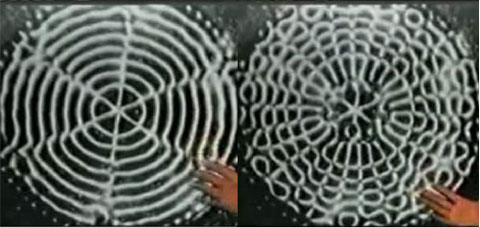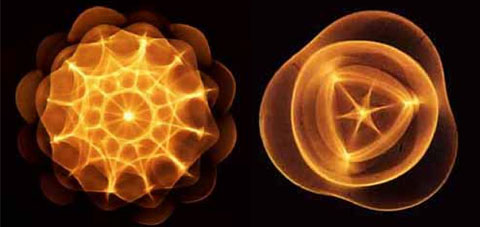Originally posted by DrStiffler
View Post
Announcement
Collapse
No announcement yet.
Joulethief SEC exciter and variants
Collapse
X
-
To be honest, I don't understand the part with negative resistance effect, so I can't comment on that. I did see significant differences in the spectra of different transistors in the simulator, so I just wanted to mention that. These may or may not show this negative resistance effect. I don't know. All I know is that these two show similar results in the FFT on the simulator as the MPSA06, so if you/someone need a replacement, these might be the first ones to try.
-
pancake results
Hi all
I have tried all my small transistors. the best is the 2N3904 for small voltage range and low current.
But to go much higher 24 volt and probably higher i used the TIP 31 C. With 300 ma i can light my 60 led ramp brightly, plus at full brightness the led across B and E of the transistor (see on the right of the pix), and i can light wirelessly a CFL . Very good for a so compact config.
I could not get a FET working (have to test more)
The same TIP 31 C and my Slayer exciter is stronger, but get much hotter and draw much more current for less volts (10 volts and 650 ma).
So very different output and very interesting stuff.
What do you think of winding a bifilar Tesla pancake of 100 turns in 0.3 mm copper. Actually my coil is 70 turns with o.4 mm copper.?

LaurentLast edited by woopy; 01-26-2011, 10:47 AM.
Comment
-
Interesting. That is exactly the one showing the largest bandwidth in the Spice simulator, comparable to the MPSA06 in that sense.... (see: http://www.energeticforum.com/renewa...tml#post114813 )Originally posted by woopy View PostI have tried all my small transistors. the best is the 2N3904 for small voltage range and low current.
Comment
-
Help with Stiffler towers
I have scoured the net and still haven't found anyone describing how to build the Stiffler towers. If someone would please provide me the specs. Lidmotor has demoed lost and so has Stiffer himself. but no specs. I could guess but would prefer actual specs so I can do a decent duplication.
PVC pipe length
Coil - number of turns
Coil - Wire size.
Thanks in advance!
Goldfinder
Comment
-
@GoldfinderOriginally posted by Goldfinder View PostI have scoured the net and still haven't found anyone describing how to build the Stiffler towers. If someone would please provide me the specs. Lidmotor has demoed lost and so has Stiffer himself. but no specs. I could guess but would prefer actual specs so I can do a decent duplication.
PVC pipe length
Coil - number of turns
Coil - Wire size.
Thanks in advance!
Goldfinder
I even think you sent us an email stating you searched the earth for this info, yet a simple click to my web site or to Scribd for the Wireless-OneWire-Energy-Transmission-Construction-Guide posted there in July 2009 would have answered you question. Crazy on such effort......Last edited by DrStiffler; 11-02-2010, 05:44 PM.
Comment
-
Nice work Woopy. I wound a Bifilar pancake coil yesterday.Originally posted by woopy View PostHi all
I have tried all my small transistors. the best is the 2N3904 for small voltage range and low current.
But to go much higher 24 volt and probably higher i used the TIP 31 C. With 300 ma i can light my 60 led ramp brightly, plus at full brightness the led across B and E of the transistor (see on the right of the pix), and i can light wirelessly a CFL . Very good for a so compact config.
I could not get a FET working (have to test more)
The same TIP 31 C and my Slayer exciter is stronger, but get much hotter and draw much more current for less volts (10 volts and 650 ma).
So very different output and very interesting stuff.
What do you think of winding a bifilar Tesla pancake of 100 turns in 0.3 mm copper. Actually my coil is 70 turns with o.4 mm copper.?

Laurent
YouTube - Bifilar Pancake Coil driven by Bedini circuit
Comment
-
the red tesla bifilar coil ready to go
Thanks Jiffycoil
i made one of those coils
the two winding separated are each 4.8 ohms and 0.47 mh. and than connected in serie as per Tesla coil
9.4 ohm and 1.84 mh.
I do not know the turn numbers but it the same diameter as my previous single wire pancake.
Pix 3 is the L2 exciting pancake coil with 6 turns
will test tomorrow
good night at all
LaurentLast edited by woopy; 01-26-2011, 10:47 AM.
Comment
-
Hehe Jiffycoil
I am not so wise but i am able to detect the good and practical advices in this forum
thanks very much for your great contribution in general and especially for this really simple trick how to wind easily a pancake coil with a single scotch tape.
And tomorrow will bring other results good or not good but for sure a lot of fun

Laurent
Comment
-
Originally posted by DrStiffler View PostSo if I read this right the cores of the two xformers are not mutually connected?
It is basically the same thing as what you/others do with the wireless towers. Only in this case, you connect them directly or trough couple capacitors. See attachment.Attached Files
Comment
-
Pancake coils
@Woopy
I replicated your two flattened pancake coil design and got good results. It works.
@ Jiffycoil
Your bifilar coil looks like another winner and I'll try that next. There is so much information on packcake coil design that it is kinda hard to filter through it all. Tesla sure did like these things.
Cheers,
Lidmotor
Comment
-
I did some analysis on coils some time ago, and found an interesting figure back then:Originally posted by Lidmotor View Post@ Jiffycoil
Your bifilar coil looks like another winner and I'll try that next. There is so much information on packcake coil design that it is kinda hard to filter through it all. Tesla sure did like these things.
http://www.energeticforum.com/renewa...html#post59469
http://www.energeticforum.com/renewa...html#post59740
I have always wondered what would be so special about a flat spiral and why Tesla would use such a coil. Now I realise you get an extreme h/d, nearing to 0. Now take a look at this figure, the base of an approximation to calculate the first TEM self-resonance frequency of a coil I posted before:

Today, I would think it's the other way around and that with a pancake coil you mostly have capacitive coupling and hardly any magnetic component, especially if you use higher harmonic resonances as you do with these kind of circuits, because your driving coil (together with the feedback coil) is the one that determines the oscillation frequency to a large degree and that one is usually much shorter than high voltage coil and thus has a (much) higher resonance frequency.What you see is that the velocity factor, the relative propagation speed with which EM electricity travels in/out of the coil, in the extreme nears to 0 also!
Very interesting!
What you have with a flat, spiral coil, is minimal capacitive coupling, while still having a considerable inductive coupling between the windings.
Update 3: note that Tesla used bifilar wound pancake coils also:
Tesla Bifilar Coil patent - Bedini Bifilar Coil usage in Schoolgirl Radiant Motor Charging devices | MERLib.org
Practical Guide to Free-Energy Devices - Chapter 9Tesla explains that a standard coil of 1000 turns with a potential of 100 volts across it will have a difference of .1 volt between turns. A similar bifilar coil will have a potential of 50 volts between turns. In that the stored energy is a function of the square of the voltages, the energy in the bifilar will be 502/.12 = 2500/.01 = 250,000 times greater than the standard coil!"
May I also remark that it might be worth experimenting with the “pancake” coil (called a bi-filar series-connected coil) patented by Tesla because he found that it was particularly effective in picking up Zero-Point Energy:
Update: I suddenly wonder what would happen if you would go to 3D coils, i.e. wind them like your grandmother would wind a ball of wool:

Then you would have one terminal in the centre of a ball-like structure, which spirals out in 3D towards the outside.... Of course, you can wind this with an inner bal, surrounded with an outer one...
Update 2:
If indeed capacitive coupling is the dominant coupling mechanism, we would be talking about electric waves propagating from one winding to the next, which would be akin to pressure waves in a fluid, which would have an interesting analogy with acoustics. With acoustic pressure waves, one can make interesting pressure wave patterns, which would be similar to what would happen inside a resonating pancake coil. This is known as cymatics:
Cymatics
This is a 2D pattern:

In 3D, we get similar patterns:A simple experiment demonstrating the visualization of cymatics can be done by sprinkling sand on a metal plate and vibrating the plate, for example by drawing a violin bow along the edge, the sand will then form itself into standing wave patterns such as simple concentric circles. The higher the frequency, the more complex the shapes produced, with certain shapes having similarities to traditional mandala designs.

The left half of the images show the same kind of pattern, one in 2D, one in 3D. As you can see, you get a hot spot in the centre, so it may be possible to do something similar with 3D ball / wool knot shaped coils.
Update 4: There's an interesting post on this velocity factor and standing waves here:
http://www.energeticforum.com/renewa...html#post37830
The referenced article, link dead, can be retrieved from the internet archive:
Class Notes: Tesla Coils and the Failure of Lumped-Element Circuit Theory
Very interesting:
Update 5: There's a very interesting site about Tesla coils here: Tesla Secondary Simulation ProjectHowever, a true Tesla coil (circa 1894) is a velocity inhibited slow-wave helical transmission line resonator: Vmax = S×Vmin, where S is the standing wave ratio. Voltage magnification is by standing waves. Period.
Update 6: Found a very interesting paper by the same Corum who wrote the Class Notes: "Voltage Magnification by Standing Waves" http://hamwaves.com/antennas/inductance/corum.pdf
Update 7: One more picture on cymatics:
Cymatics : Physics • Rational Skepticism Forum


I like these kinds of images, because I believe there is a real ether, as Tesla always said, so these cymatic techniques enable us to make pictures and video's of how waves propagate trough the medium, be it water or the ether.Last edited by lamare; 11-04-2010, 08:45 AM. Reason: moved cymatic images to my own server; added wool ball picture
Comment
-
Hi all
Thanks to all for contributing ,it really helps to go on understanding what is going on here.
So i made some test today with Slayer and joulethief circuitery. And i have made a small vidęo to show with less words something very interesting with those pancake coils.
Perhaps the pancake coil ŕ la Ecoman will bring better results ? who knows ?
And good experimenting
Laurent
YouTube - bifilar Tesla pancake wireless coupling.wmv
Comment

Comment